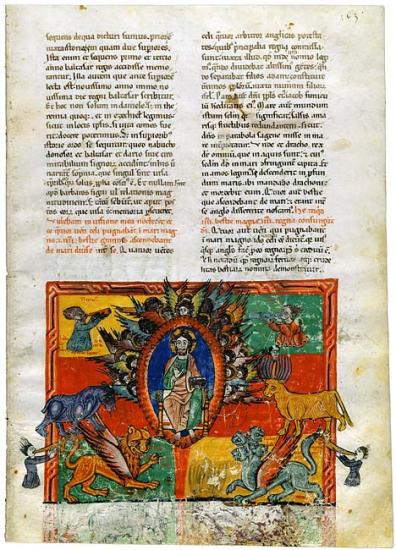
Vision Of The Elder Of Days And The Four Beasts
Beatus of Liébana
Las Huelgas Apocalypse
Purchased by Pierpont Morgan, 1910
In the first year of Belshazzar, king of Babylon, Daniel saw a dream: the four winds of the heavens fought upon the great sea, and four different great beasts rose from the sea. The first, like a lioness, had wings of an eagle; a beast, like a bear with three rows of teeth; another, like a leopard with wings and four heads; and a fourth, exceedingly strong, with great iron teeth, but with ten horns; and another little horn sprung up in the midst of the horns, with eyes like those of a man and a mouth speaking unnatural things. Then the ancient of days sat on the throne. The throne was flames of fire; and a river of fire rushed forth from his presence. Thousands upon thousands ministered to him. The trial began, and the books were opened. An attendant explained that "These four great beasts are four kingdoms, which will rise from the earth, yet it is the saints of the Most High God who will receive the kingdom, and they will hold the kingdom from this generation, and forever." And he said, "The fourth beast will be the fourth kingdom on earth, which will be greater than all the kingdoms, and will devour the whole earth, and will trample and crush it. And the ten horns will be ten kings, but another and mightier will rise up, and bring down three kings. (Dan. 7)
For Jerome, the four beasts were metaphors for the four ancient empires: the lioness represented Babylonia; the bear, Medes and the Persians; the leopard, Ptolemaic Egypt; and the beast with ten horns, Rome. The elder of the days is God. Note how the illuminator had begun to paint the bear and the fourth beast at the bottom but then whitened them out, squeezing them above the lioness and leopard. Apparently there was not enough space to give each beast its own compartment.
The Apocalypse, or Book of Revelation, is not only the last Book of the New Testament, but its most difficult, puzzling, and terrifying. It provided challenges to medieval illustrators and was the source for a number of popular images, such as Christ in Majesty, the Adoration of the Lamb, and the Madonna of the Apocalypse and contributed to the widespread use of the Evangelists' symbols.
Selected images from Apocalypse Then: Medieval Illuminations from the Morgan, an exhibition held at the Morgan are presented here. The exhibition celebrates the completion of a facsimile of the Morgan's Las Huelgas Apocalypse—the latest dated (1220) and largest surviving manuscript of a Spanish tradition of illuminated commentaries on the Apocalypse by the monk Beatus of Liébana. The series of manuscripts constitutes Spain's most important contribution to medieval manuscript illumination.
The Las Huelgas Apocalypse contains three sections: the prefatory cycle, the Apocalypse, and the Book of Daniel.
In addition to forty-nine images from the Las Huelgas Apocalypse, six images from other manuscripts in the Morgan's collections, including the earliest Beatus painted by Maius and one by the Master of the Berry Apocalypse, are in this presentation.
